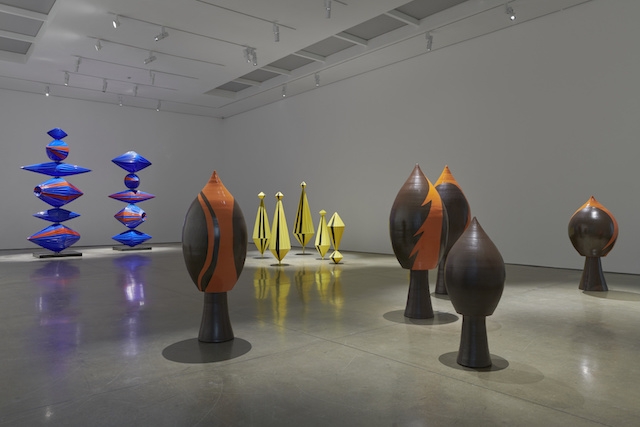For all the breadth and audacity of his output, Lee Seung-taek is surprisingly little-known, in Europe as in his native Korea. Perhaps because his experimental and independent approach meant his work evolved on the fringes of the established movements in postwar Korean art, and consequently was written out of its history; perhaps because he didn’t follow the artistic trends coming out of the West. Whatever the reason, this survey of work from the late 1950s to today – Lee’s first in the UK – offers an overdue introduction to his complex, playful and striking oeuvre.
The first of two rooms focuses on Lee’s smallscale stone sculptures and three-dimensional works on canvas from the 1970s, 1980s and 2010s, all tied together –literally and figuratively – with rope. In Godret Stone (1958), little carved rocks are suspended by hemp strings from a horizontal plank of wood. On the floor, the deep lines etched into three larger stone sculptures (all Untitled, 1978–80) suggest that they too had previously been hung by a coarse rope wrapped around their centre. On the wall, a framed sheet of paper is covered with plaster: a carved relief creates the illusion of a silky fabric being pulled downwards from a horizon line at its centre, creating an opening from which a thin rope sticks out like a tongue. Where his Japanese contemporaries in Mono-ha (the minimal aesthetics of which resonate with the work here) sought to reveal the ‘essence’ of things, Lee’s subversion of the materials’ expected behaviours seems instead to question their essential reality. He creates a realm in which stones are light and malleable, in which a flat sheet of paper or canvas reveals a hidden depth. Simultaneously, with all its erotic and violent connotations, the bondage of Lee’s materials reveals their sensuous and primal qualities, both constraining and freeing them from their forms.
In stark contrast to the opening room’s muted display, the vast lower ground floor gallery presents a colourful selection of Lee’s largescale installations from the 1960s, recreated by the artist for the exhibition. These towering sculptures are installed as three groups, evoking props in an imaginary landscape or sets at an eccentric theme park. Made from the everyday material of brightly coloured vinyl stretched on steel frames, they conjure schematic trees or totems in some cases, human figures in others. Another group, from the artist’s Oji series, named after traditional Korean earthenware jars, stands out with its earthy tones and curvilinear aesthetics, evoking something between cartoonish poplar trees and the tips of giant paintbrushes poking out of the ground. Near the exit, a series of drawings picture these installations in natural landscapes, set directly on the grass. Nature, Lee’s favourite field of experimentation, was where he furthered his interrogations into the (im)materiality of things by harnessing wind, smoke and fire as media. One can only hope that this spectacular body of work will soon be granted the same, belated recognition.
Lee Seung-taek at White Cube Mason’s Yard, London, 25 May – 30 June
From the Summer 2018 issue of ArtReview Asia
